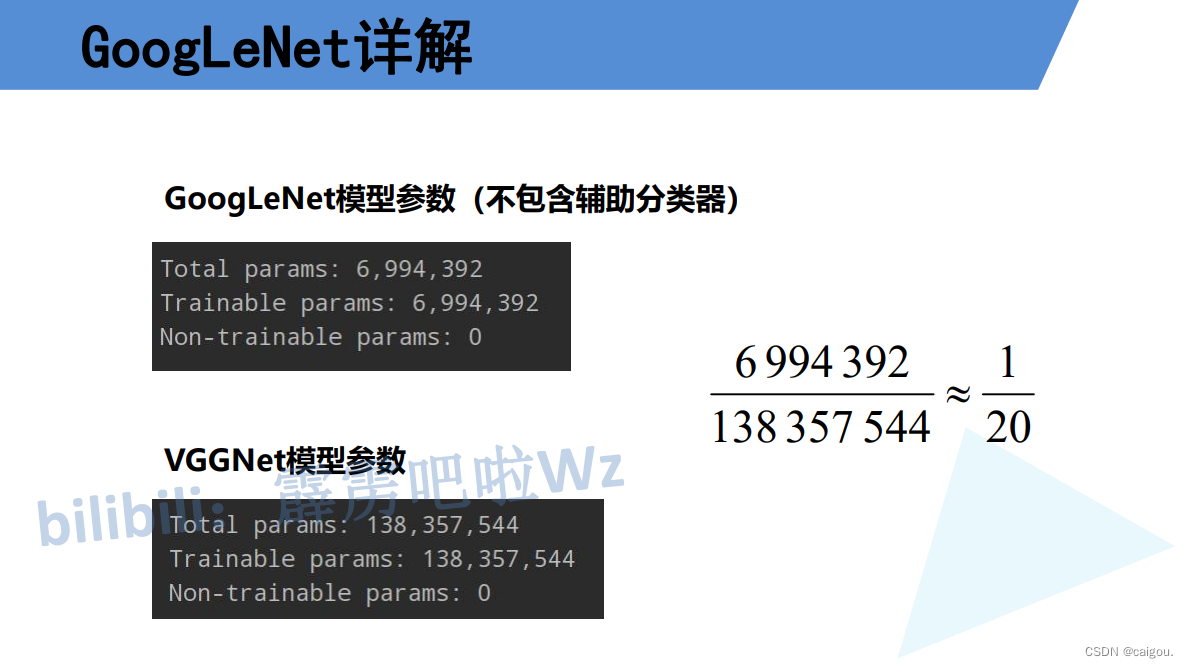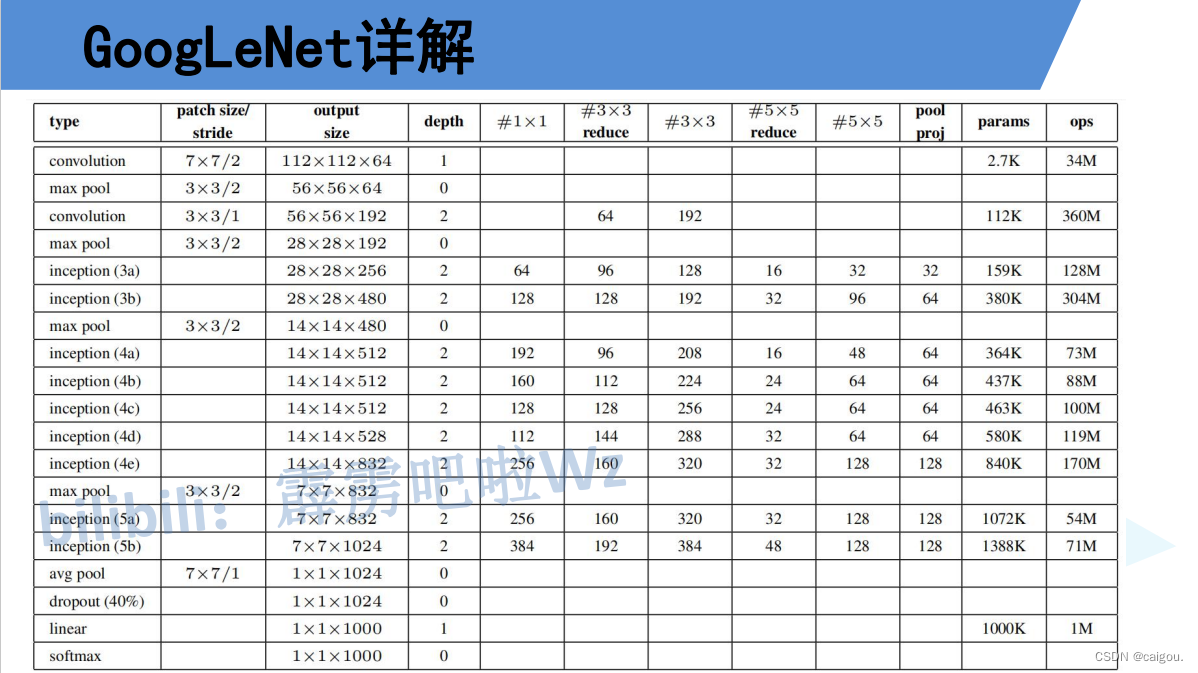亮点与创新:
1. 引入Inception基础结构
2. 引入PW维度变换卷积,启迪后续参数量的优化
3. 丢弃全连接层,使用平均池化层(大大减少模型参数)
4. 添加两个辅助分类器帮助训练(避免梯度消失,用于向前传导梯度,也有一定的正则化效果,防止过拟合)




model.py
import torch.nn as nn
import torch
import torch.nn.functional as Fclass GoogLeNet(nn.Module):def __init__(self, num_classes=1000, aux_logits=True, init_weights=False):super(GoogLeNet, self).__init__()self.aux_logits = aux_logitsself.conv1 = BasicConv2d(3, 64, kernel_size=7, stride=2, padding=3)self.maxpool1 = nn.MaxPool2d(3, stride=2, ceil_mode=True)self.conv2 = BasicConv2d(64, 64, kernel_size=1)self.conv3 = BasicConv2d(64, 192, kernel_size=3, padding=1)self.maxpool2 = nn.MaxPool2d(3, stride=2, ceil_mode=True)self.inception3a = Inception(192, 64, 96, 128, 16, 32, 32)self.inception3b = Inception(256, 128, 128, 192, 32, 96, 64)self.maxpool3 = nn.MaxPool2d(3, stride=2, ceil_mode=True)self.inception4a = Inception(480, 192, 96, 208, 16, 48, 64)self.inception4b = Inception(512, 160, 112, 224, 24, 64, 64)self.inception4c = Inception(512, 128, 128, 256, 24, 64, 64)self.inception4d = Inception(512, 112, 144, 288, 32, 64, 64)self.inception4e = Inception(528, 256, 160, 320, 32, 128, 128)self.maxpool4 = nn.MaxPool2d(3, stride=2, ceil_mode=True)self.inception5a = Inception(832, 256, 160, 320, 32, 128, 128)self.inception5b = Inception(832, 384, 192, 384, 48, 128, 128)if self.aux_logits:self.aux1 = InceptionAux(512, num_classes)self.aux2 = InceptionAux(528, num_classes)self.avgpool = nn.AdaptiveAvgPool2d((1, 1))self.dropout = nn.Dropout(0.4)self.fc = nn.Linear(1024, num_classes)if init_weights:self._initialize_weights()def forward(self, x):# N x 3 x 224 x 224x = self.conv1(x)# N x 64 x 112 x 112x = self.maxpool1(x)# N x 64 x 56 x 56x = self.conv2(x)# N x 64 x 56 x 56x = self.conv3(x)# N x 192 x 56 x 56x = self.maxpool2(x)# N x 192 x 28 x 28x = self.inception3a(x)# N x 256 x 28 x 28x = self.inception3b(x)# N x 480 x 28 x 28x = self.maxpool3(x)# N x 480 x 14 x 14x = self.inception4a(x)# N x 512 x 14 x 14if self.training and self.aux_logits: # eval model lose this layeraux1 = self.aux1(x)x = self.inception4b(x)# N x 512 x 14 x 14x = self.inception4c(x)# N x 512 x 14 x 14x = self.inception4d(x)# N x 528 x 14 x 14if self.training and self.aux_logits: # eval model lose this layeraux2 = self.aux2(x)x = self.inception4e(x)# N x 832 x 14 x 14x = self.maxpool4(x)# N x 832 x 7 x 7x = self.inception5a(x)# N x 832 x 7 x 7x = self.inception5b(x)# N x 1024 x 7 x 7x = self.avgpool(x)# N x 1024 x 1 x 1x = torch.flatten(x, 1)# N x 1024x = self.dropout(x)x = self.fc(x)# N x 1000 (num_classes)if self.training and self.aux_logits: # eval model lose this layerreturn x, aux2, aux1return xdef _initialize_weights(self):for m in self.modules():if isinstance(m, nn.Conv2d):nn.init.kaiming_normal_(m.weight, mode='fan_out', nonlinearity='relu')if m.bias is not None:nn.init.constant_(m.bias, 0)elif isinstance(m, nn.Linear):nn.init.normal_(m.weight, 0, 0.01)nn.init.constant_(m.bias, 0)class Inception(nn.Module):def __init__(self, in_channels, ch1x1, ch3x3red, ch3x3, ch5x5red, ch5x5, pool_proj):super(Inception, self).__init__()self.branch1 = BasicConv2d(in_channels, ch1x1, kernel_size=1)self.branch2 = nn.Sequential(BasicConv2d(in_channels, ch3x3red, kernel_size=1),BasicConv2d(ch3x3red, ch3x3, kernel_size=3, padding=1) # 保证输出大小等于输入大小)self.branch3 = nn.Sequential(BasicConv2d(in_channels, ch5x5red, kernel_size=1),# 在官方的实现中,其实是3x3的kernel并不是5x5,这里我也懒得改了,具体可以参考下面的issue# Please see https://github.com/pytorch/vision/issues/906 for details.BasicConv2d(ch5x5red, ch5x5, kernel_size=5, padding=2) # 保证输出大小等于输入大小)self.branch4 = nn.Sequential(nn.MaxPool2d(kernel_size=3, stride=1, padding=1),BasicConv2d(in_channels, pool_proj, kernel_size=1))def forward(self, x):branch1 = self.branch1(x)branch2 = self.branch2(x)branch3 = self.branch3(x)branch4 = self.branch4(x)outputs = [branch1, branch2, branch3, branch4]return torch.cat(outputs, 1)class InceptionAux(nn.Module):def __init__(self, in_channels, num_classes):super(InceptionAux, self).__init__()self.averagePool = nn.AvgPool2d(kernel_size=5, stride=3)self.conv = BasicConv2d(in_channels, 128, kernel_size=1) # output[batch, 128, 4, 4]self.fc1 = nn.Linear(2048, 1024)self.fc2 = nn.Linear(1024, num_classes)def forward(self, x):# aux1: N x 512 x 14 x 14, aux2: N x 528 x 14 x 14x = self.averagePool(x)# aux1: N x 512 x 4 x 4, aux2: N x 528 x 4 x 4x = self.conv(x)# N x 128 x 4 x 4x = torch.flatten(x, 1)x = F.dropout(x, 0.5, training=self.training)# N x 2048x = F.relu(self.fc1(x), inplace=True)x = F.dropout(x, 0.5, training=self.training)# N x 1024x = self.fc2(x)# N x num_classesreturn xclass BasicConv2d(nn.Module):def __init__(self, in_channels, out_channels, **kwargs):super(BasicConv2d, self).__init__()self.conv = nn.Conv2d(in_channels, out_channels, **kwargs)self.relu = nn.ReLU(inplace=True)def forward(self, x):x = self.conv(x)x = self.relu(x)return x
train.py
模型有三个返回结果,一个预测,两个辅助分类器
import os
import sys
import jsonimport torch
import torch.nn as nn
from torchvision import transforms, datasets
import torch.optim as optim
from tqdm import tqdmfrom model import GoogLeNetdef main():device = torch.device("cuda:0" if torch.cuda.is_available() else "cpu")print("using {} device.".format(device))data_transform = {"train": transforms.Compose([transforms.RandomResizedCrop(224),transforms.RandomHorizontalFlip(),transforms.ToTensor(),transforms.Normalize((0.5, 0.5, 0.5), (0.5, 0.5, 0.5))]),"val": transforms.Compose([transforms.Resize((224, 224)),transforms.ToTensor(),transforms.Normalize((0.5, 0.5, 0.5), (0.5, 0.5, 0.5))])}data_root = os.path.abspath(os.path.join(os.getcwd(), "../..")) # get data root pathimage_path = os.path.join(data_root, "data_set", "flower_data") # flower data set pathassert os.path.exists(image_path), "{} path does not exist.".format(image_path)train_dataset = datasets.ImageFolder(root=os.path.join(image_path, "train"),transform=data_transform["train"])train_num = len(train_dataset)# {'daisy':0, 'dandelion':1, 'roses':2, 'sunflower':3, 'tulips':4}flower_list = train_dataset.class_to_idxcla_dict = dict((val, key) for key, val in flower_list.items())# write dict into json filejson_str = json.dumps(cla_dict, indent=4)with open('class_indices.json', 'w') as json_file:json_file.write(json_str)batch_size = 32nw = min([os.cpu_count(), batch_size if batch_size > 1 else 0, 8]) # number of workersprint('Using {} dataloader workers every process'.format(nw))train_loader = torch.utils.data.DataLoader(train_dataset,batch_size=batch_size, shuffle=True,num_workers=nw)validate_dataset = datasets.ImageFolder(root=os.path.join(image_path, "val"),transform=data_transform["val"])val_num = len(validate_dataset)validate_loader = torch.utils.data.DataLoader(validate_dataset,batch_size=batch_size, shuffle=False,num_workers=nw)print("using {} images for training, {} images for validation.".format(train_num,val_num))# test_data_iter = iter(validate_loader)# test_image, test_label = test_data_iter.next()net = GoogLeNet(num_classes=5, aux_logits=True, init_weights=True)# 如果要使用官方的预训练权重,注意是将权重载入官方的模型,不是我们自己实现的模型# 官方的模型中使用了bn层以及改了一些参数,不能混用# import torchvision# net = torchvision.models.googlenet(num_classes=5)# model_dict = net.state_dict()# # 预训练权重下载地址: https://download.pytorch.org/models/googlenet-1378be20.pth# pretrain_model = torch.load("googlenet.pth")# del_list = ["aux1.fc2.weight", "aux1.fc2.bias",# "aux2.fc2.weight", "aux2.fc2.bias",# "fc.weight", "fc.bias"]# pretrain_dict = {k: v for k, v in pretrain_model.items() if k not in del_list}# model_dict.update(pretrain_dict)# net.load_state_dict(model_dict)net.to(device)loss_function = nn.CrossEntropyLoss()optimizer = optim.Adam(net.parameters(), lr=0.0003)epochs = 30best_acc = 0.0save_path = './googleNet.pth'train_steps = len(train_loader)for epoch in range(epochs):# trainnet.train()running_loss = 0.0train_bar = tqdm(train_loader, file=sys.stdout)for step, data in enumerate(train_bar):images, labels = dataoptimizer.zero_grad()logits, aux_logits2, aux_logits1 = net(images.to(device))loss0 = loss_function(logits, labels.to(device))loss1 = loss_function(aux_logits1, labels.to(device))loss2 = loss_function(aux_logits2, labels.to(device))loss = loss0 + loss1 * 0.3 + loss2 * 0.3loss.backward()optimizer.step()# print statisticsrunning_loss += loss.item()train_bar.desc = "train epoch[{}/{}] loss:{:.3f}".format(epoch + 1,epochs,loss)# validatenet.eval()acc = 0.0 # accumulate accurate number / epochwith torch.no_grad():val_bar = tqdm(validate_loader, file=sys.stdout)for val_data in val_bar:val_images, val_labels = val_dataoutputs = net(val_images.to(device)) # eval model only have last output layerpredict_y = torch.max(outputs, dim=1)[1]acc += torch.eq(predict_y, val_labels.to(device)).sum().item()val_accurate = acc / val_numprint('[epoch %d] train_loss: %.3f val_accuracy: %.3f' %(epoch + 1, running_loss / train_steps, val_accurate))if val_accurate > best_acc:best_acc = val_accuratetorch.save(net.state_dict(), save_path)print('Finished Training')if __name__ == '__main__':main()
注意训练代码里的这段注释代码:
import torchvisionnet = torchvision.models.googlenet(num_classes=5)#如果用的是官方提供的torchvision.models.googlenet模型,下载下来官方训练的权重是在imagenet1000分类上训练到的权重,需要删除一些层的权重来训练,而且训练的模型直接就是官方的模型,得到自己适应训练集的权重,简单总结,官方模型,官方权重,自己数据集,稍微修改官方权重,使用稍微修改的官方权重训练官方模型下自己数据集的权重
#对于怎么冻结权重,解冻权重,由于这个模型学习时还在训练前面的VGG网络,到resnet进行学习#若想用官方权重训练自己的模型得到适应数据集的权重,也应该是修改一下官方权重
#之后resnet细说model_dict = net.state_dict()# 预训练权重下载地址: https://download.pytorch.org/models/googlenet-1378be20.pthpretrain_model = torch.load("googlenet.pth")del_list = ["aux1.fc2.weight", "aux1.fc2.bias","aux2.fc2.weight", "aux2.fc2.bias","fc.weight", "fc.bias"]pretrain_dict = {k: v for k, v in pretrain_model.items() if k not in del_list}model_dict.update(pretrain_dict)net.load_state_dict(model_dict)predict.py
import os
import jsonimport torch
from PIL import Image
from torchvision import transforms
import matplotlib.pyplot as pltfrom model import GoogLeNetdef main():device = torch.device("cuda:0" if torch.cuda.is_available() else "cpu")data_transform = transforms.Compose([transforms.Resize((224, 224)),transforms.ToTensor(),transforms.Normalize((0.5, 0.5, 0.5), (0.5, 0.5, 0.5))])# load imageimg_path = "../tulip.jpg"assert os.path.exists(img_path), "file: '{}' dose not exist.".format(img_path)img = Image.open(img_path)plt.imshow(img)# [N, C, H, W]img = data_transform(img)# expand batch dimension#对单张图片添加维度,以适应模型#如果是批次预测,之后注意批次预测的代码怎么设计img = torch.unsqueeze(img, dim=0)# read class_indictjson_path = './class_indices.json'assert os.path.exists(json_path), "file: '{}' dose not exist.".format(json_path)with open(json_path, "r") as f:class_indict = json.load(f)# create modelmodel = GoogLeNet(num_classes=5, aux_logits=False).to(device)# load model weightsweights_path = "./googleNet.pth"assert os.path.exists(weights_path), "file: '{}' dose not exist.".format(weights_path)missing_keys, unexpected_keys = model.load_state_dict(torch.load(weights_path, map_location=device),strict=False)model.eval()with torch.no_grad():# predict classoutput = torch.squeeze(model(img.to(device))).cpu()predict = torch.softmax(output, dim=0)predict_cla = torch.argmax(predict).numpy()print_res = "class: {} prob: {:.3}".format(class_indict[str(predict_cla)],predict[predict_cla].numpy())plt.title(print_res)for i in range(len(predict)):print("class: {:10} prob: {:.3}".format(class_indict[str(i)],predict[i].numpy()))plt.show()if __name__ == '__main__':main()
:eMios功能点阅读随记)


—命名空间与资源配额)
![[Verilog] 设计方法和设计流程](http://pic.xiahunao.cn/[Verilog] 设计方法和设计流程)




)
)







路由协议以及相关配置)
